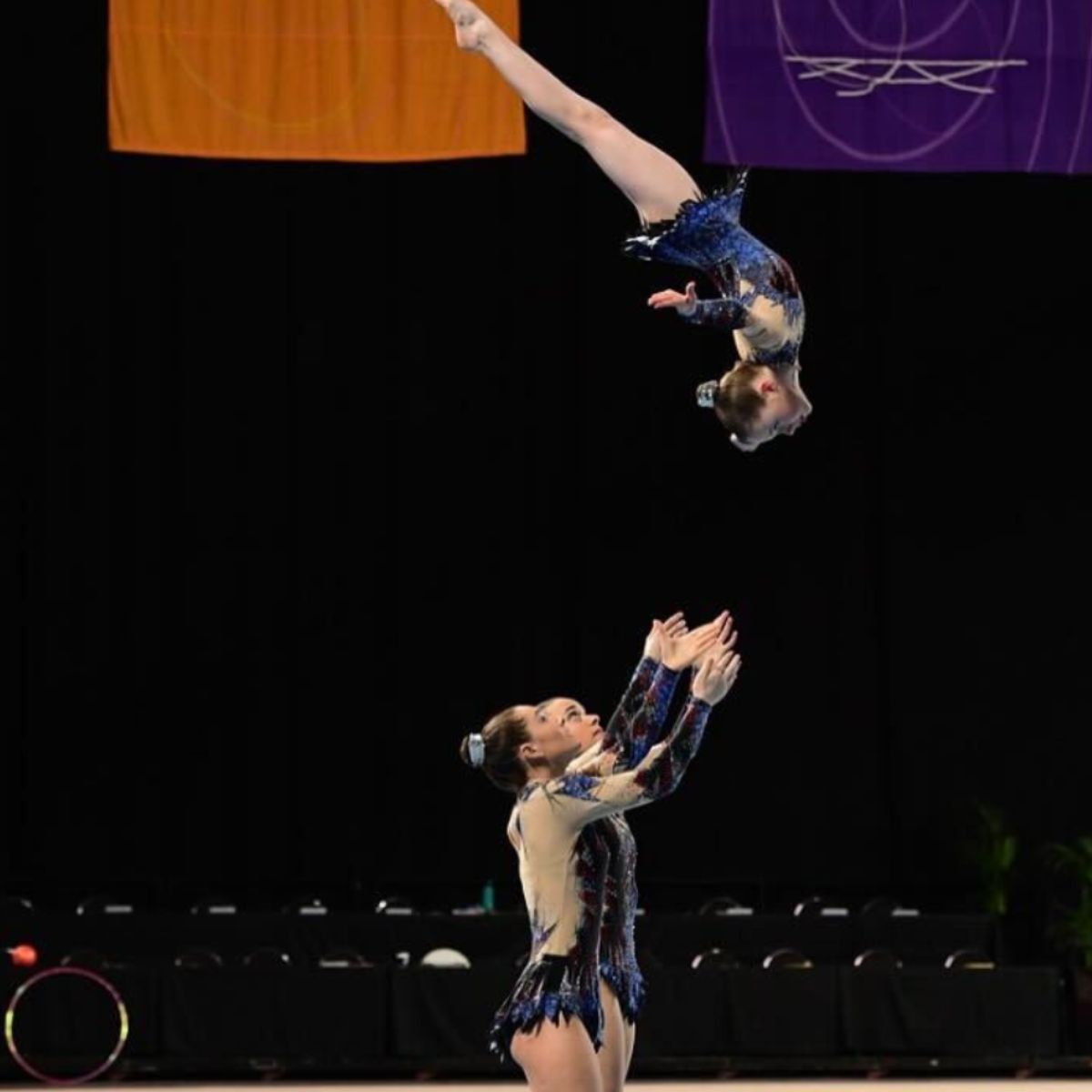We know you understand what gymnastics is, but did you know that rhythmic gymnastics exists? That's right, it's not just another form of gymnastics moves; it's a breathtaking art that combines athleticism with sheer grace and creativity.
As a gymnastics trainer, I'm beyond excited to share our compilation of facts about rhythmic gymnastics.
In addition to flips and tumbles, rhythmic gymnastics is a mesmerizing show of flexibility, coordination, and artistry.
What is Rhythmic Gymnastics?
Let's first define rhythmic gymnastics before we get into the amazing facts. Ballet, dance, and gymnastics are all included in the artistic and expressive Olympic sport known as rhythmic gymnastics. Rhythmic gymnastics, which uses portable gear like hoops, balls, ribbons, clubs, and ropes to accomplish its routines, lays a significant emphasis on fluidity, flexibility, and complex choreography in contrast to its counterpart, artistic gymnastics, which is known for its explosive flips and twists.
Brief History:
According to Olympics.com, Olympic rhythmic gymnastics is a female-only competition that uses apparatus to display musicality, talent, and flexibility. It made its Olympic debut at the 1984 Los Angeles Games. Individual all-around women and group all-around women are the only two categories.
Wikipedia discussed the rhythmic gymnastics discovery timeline as follows:
Pioneers of Movement Expression:
Rudolf Bode (1881-1970), François Delsarte (1811-1871), and Jean-Georges Noverre (1727-1810) believed in the expressive power of movement, using dance to convey emotions and exercise various body parts. Their ideas laid the foundation for the emergence of rhythmic gymnastics.
Evolution of Movement Expression:
Peter Henry Ling's 19th-century Swedish System introduced "aesthetic gymnastics," encouraging communication of feelings and emotions through physical movement. Catharine Beecher, who established the Western Female Institute in Cincinnati, Ohio, USA, implemented the "Dance without Dancing" program. This combined gymnastics exercises with music, progressing from easy callisthenics to challenging exercises, enhancing physical expression.
Genevieve Stebbins, in her groundbreaking book "The Delsarte System of Expression" (1885), introduced "harmonic gymnastics." This enabled late 19th-century American women to express themselves physically, particularly through dance. Stebbins empowered middle-class and upper-class women, providing them with tools and models for appropriate physical practices.
Rhythmic Gymnastics vs Artistic Gymnastics
One common question we usually encounter is the difference between rhythmic gymnastics and artistic gymnastics. While both disciplines share the foundation of gymnastics, they differ significantly in their routines and apparatus. Rhythmic gymnastics is a symphony of elegant movements and enchanting dance performed with grace and finesse. Artistic gymnastics, on the other hand, showcases raw power, acrobatics, and jaw-dropping flips and twists.

Interesting Facts About Rhythmic Gymnastics
Fact #1: Rhythmic gymnastics is an Olympic sport.
Yes, you heard it right! Rhythmic gymnastics isn't just a beautiful art form and a highly competitive Olympic sport. Athletes from all around the globe showcase their talent, dedication, and creativity on the Olympic Games' grandest sporting stage.
Fact #2: Rhythmic gymnastics originated in Europe.
In Europe, rhythmic gymnastics emerged and developed into the captivating sport we know today. Russia and Bulgaria, in particular, have long dominated the rhythmic gymnastics scene in Europe, exhibiting their extraordinary talent and artistry on a global scale.
Fact #3: Rhythmic gymnasts often start at a young age.
Many rhythmic gymnasts begin their training at an extremely young age. It's not unusual to see young children excitedly embracing the world of rhythmic gymnastics, even as early as five or six years old. These athletes can build their flexibility, coordination, and strength early on, setting the groundwork for their success in the future.
Fact #4: Rhythmic gymnasts compete individually and in group events.
Rhythmic gymnastics offers the best of both worlds. Gymnasts have the opportunity to shine individually, captivating the audience with their solo performances. Additionally, they come together to form harmonious groups, where their collective talent and synchronization create awe-inspiring routines that leave spectators in sheer amazement.
Fact #5: The first ideas related to rhythmic gymnastics date back to the 18th century.
Believe it or not, the enchanting concept of rhythmic gymnastics has been brewing for centuries. The earliest clues of this art form emerged in the 18th century when visionaries began exploring the fusion of dance and gymnastics, paving the way for the spectacular displays we witness today.
Fact #6: The first Olympic champion in rhythmic gymnastics was Canadian.
Canada has a unique place in rhythmic gymnastics history. Canadians won the first-ever rhythmic gymnastics Olympic gold medal. This outstanding accomplishment was a turning point in the sport's ascent to international acclaim. It inspired a generation of players to pursue their goals.
Fact #7: Rhythmic gymnastics has a complex scoring system.
Have you ever wondered how judges assess rhythmic gymnasts' breathtaking displays? In rhythmic gymnastics, the scoring is extremely complicated. To determine scores, judges consider several factors, such as execution, difficulty, creative expression, and apparatus handling mastery. Gymnasts must devote years to practise and effort to grasp these nuances and give outstanding performances.
Fact #8: Rhythmic gymnastics is heavily influenced by ballet.
Ballet enthusiasts, rejoice! Rhythmic gymnastics draws significant inspiration from the world of ballet. The graceful movements, exquisite posture, and fluid transitions seen in rhythmic gymnastics routines mirror the elegance of ballet. This influence infuses the sport with a unique blend of athleticism and artistry, creating a mesmerizing spectacle for the audience.
Fact #9: Rhythmic gymnastics is one of the two female-only Olympic sports.
Among the many sports offered in the Olympics, rhythmic gymnastics stands out as one of only two open to female competitors. This demonstrates women's extraordinary talent and power in sports, motivating generations of young girls to pursue their love of rhythmic gymnastics.
Fact #10: Gymnasts cannot talk to each other during a routine.
Have you ever wondered how gymnasts keep their perfect synchrony throughout group routines? Here's the deal: they communicate nonverbally and instead through their actions. Gymnasts are prohibited from speaking to one another while performing a routine, highlighting the value of non-verbal signs, trust, and collaboration. Group performances become even more intricate due to this tacit collaboration, adding to an already impressive level of intricacy.
Frequently Asked Questions
Can you shift from acrobatic gymnastics to rhythmic gymnastics?
Switching from acrobatic gymnastics to rhythmic gymnastics means entering a whole new world. In acrobatic gymnastics, teamwork and strength are important. In contrast, individual skills with apparatus like hoops and ribbons are showcased in rhythmic gymnastics. Flexibility and artistic expression are also crucial, and a good coach is essential. Practice is key to mastering routines, and competitions are where hard work pays off.
Do men compete in rhythmic gymnastics?
Although females tend to perform rhythmic gymnastics more frequently, male rhythmic gymnasts exist. Men are now competing in rhythmic gymnastics events in some nations.
Can rhythmic gymnasts compete in other gymnastics events?
Rhythmic gymnasts are experts in their field, but they may also have experience in artistic or acrobatic gymnastics. Although the talents are similar, the disciplines are separate.
What do rhythmic gymnasts wear?
Gymnasts wear leotards during their performances. These leotards are often colourful and embellished, reflecting the artistic nature of the sport.
Conclusion
Rhythmic gymnastics isn't just about flips and ribbons; it's a story of perseverance and grace echoing through time. It's a reminder that we can achieve the extraordinary with dedication and a sprinkle of dreams.
So, whether you're motivated to try a twirl or admire the beauty of movement, keep rhythmic gymnastics in your heart. And who knows, the next time you watch those exquisite gymnasts, you'll feel part of their silent discourse, noticing the enchantment in every motion.

